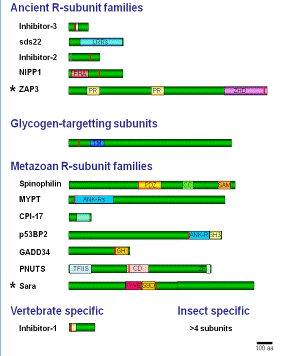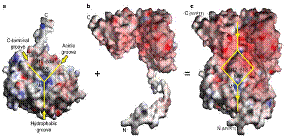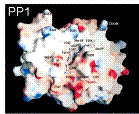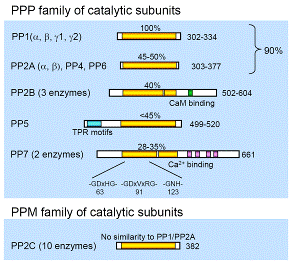




|
Research |
|
Much of our attention is focussed on using the power of Drosophila genetics to determine the role and regulation of protein phosphatases such as Protein Phosphatase 1 (PP1), a major class of Serine/Threonine protein phosphatases (see |
|
Research
|
|
Introduction |
|
Introduction |
|
Home Research People Publications News Contact us |
|
below). The importance of PP1 is highlighted by the fact that it is one of the most highly conserved enzymes identified to date and together with PP2A, contributes about 90% of the total Ser/Thr phosphatase activity in mammalian cells.
|



|
Our work on PP1 has shed light on the in vivo roles of PP1 catalytic subunits, their associated proteins (the PP1 interactome), the regulation of transcriptional memory by chromosome-associated PP1, roles of PP1-containing complexes in intracellular signalling and other related themes. In addition to dissecting the contribution of PP1-associated proteins to normal developmental processes, we are using various Drosophila cancer models to determine their roles in tumourigenesis and metastasis. |
|
In vitro, PP1 catalytic subunits have overlapping and pleiotropic functions (Kirchner et al. 2007a; Bennett et al. 2003). However, in vivo, the PP1 catalytic subunit is associated with a diverse collection of regulatory subunits (Bennett & Alphey 2007, Bennett et al. 2006) that have the potential to target PP1 to specific locations and modify its substrate specificity (e.g. Tan et al 2008). Regulatory subunits also have roles in phosphatase biosynthesis and/or inhibition (Parker et al 2002; Bennett et al. 1999). The regulatory subunits are therefore the key to understanding the role of PP1 in particular biological processes. The existence of isoform specific PP1 regulatory subunits may also help to explain the unique roles of different PP1 catalytic subunits (Kirchner et al. 2007b, Vereshchagina et al. 2004).
PP1 regulatory proteins can be classified according to their phylogenetic lineage and demonstrated functional properties (e.g. see right top). Co-crystallisation studies have provided important structural insight into how catalytic and regulatory subunits interact (e.g. right bottom, taken from Nature 2004, 429: 780-4). |
|
Our work, together with that of other labs, has revealed that... |

|
Cell signalling and Development in Drosophila |
|
Bennett Lab |
